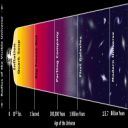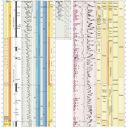Deep Time
Time
This unit is one of the two starting points for the new Palaeos, the other being cosmic evolution.
In order to understand the evolution of life, the Earth, and the cosmos as a whole, we need to understand deep time. In other words, it is necessary to think in terms of millions, tens or hundreds of millions, or even billions of years. Geologists pioneered the discovery of Deep Time in the 18th and 19th century, overthrowing the ridiculously short biblical timescales that were standard until then. Their work was further taken up by astronomers and physicists speculating on the age of the universe.
In describing big history, the history and evolution of life, the universe, and everything, a number of distinct but overlapping types and scales of timeline are often posited. Among these are Cosmological time, Geological Time, Quaternary Time, and Historical Time. Of these, we only go into detail regarding geological time, as this is the one that is most relevant to (and used to define) the major stages in the history of life on Earth. The other two timescales are given only a very cursory review.
In the diagram on the left, there are two timescales which overlap, cosmological and geological time. Then right at the very end we could have a very brief further one, archeological time, from the Lower Palaeolithic (old stone age) onwards. History doesn't even figure at this scale.
The only way to integrate all of these different timescales, the five thousand years of recorded history and five billion years of Earth history, and even for that matter the 13.7 (or perhaps longer, as there are stars that seem to be older than that age see however link link) cosmological timeline and what you did yesterday, in a single scale is to use a Logarithmic Timeline. Most of Palaeos however, especially when we get the history of life and of the Earth, is based on the middle of this spectrum, generally five or ten million or so year intervals, although in some instances such as the Cenozoic it is possible to get down to a reliable one million year resolution. MAK110725, 110915
Five Types of Timeline
The following gives a brief overview of some of the various possible timescales:
A few links: James Childs Universe - a large number of post-like diagrams, based on the general theme of cosmic evolution; Niel Brandt's Timelines and Scales of Measurement Page includes a number of timelines and scales, including logarithmic, historical, etc, which together encompass a big history / cosmic evolution approach; Universe Timeline by Alexander Kozik - what it says.





